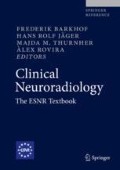Abstract
Spontaneous, nontraumatic intracerebral hemorrhage (ICH) is an important cause of morbidity and mortality worldwide. The etiology of spontaneous intracerebral hemorrhage is vast and includes, among other causes, hypertension, cerebral amyloid angiopathy, cerebral venous thrombosis, hemorrhagic transformation of ischemic infarction, cerebral aneurysms, and vascular malformations (such as cavernomas, dural arteriouvenous fistulas, and arteriovenous malformations). Clinical neuroradiology plays an important role in ICH to establish the diagnosis, to identify the cause of the hemorrhage, and to guide often emergent patient treatment. Radiological techniques important in the exploration of ICH include computed tomography (CT), magnetic resonance imaging (MRI), and digital substraction angiography (DSA). In this chapter, we discuss the radiologic manifestations of ICH on various imaging methods, and provide a broad overview of the most frequent causes of spontaneous ICH.

This publication is endorsed by: European Society of Neuroradiology (www.esnr.org).
Access this chapter
Tax calculation will be finalised at checkout
Purchases are for personal use only
Abbreviations
- AVM:
-
Arteriovenous malformation
- BBB:
-
Blood-brain barrier
- CAA:
-
Cerebral amyloid angiopathy
- CNS:
-
Central nervous system
- CSF:
-
Cerebrospinal fluid
- cSS:
-
Cortical superficial siderosis
- CT:
-
Cerebral venous thrombosis
- CVD:
-
Cortical venous drainage
- dAVF:
-
Dural arteriovenous fistula
- deoxy-Hb:
-
Deoxyhemoglobin
- DSA:
-
Digital substraction angiography
- DVA:
-
Developmental venous anomaly
- DWI:
-
Diffusion-weighted imaging
- GRE:
-
Gradient-recalled echo
- Hb:
-
Hemoglobin
- HI:
-
Hemorrhagic infarction
- HT:
-
Hemorrhagic transformation
- ICH:
-
Intracerebral hemorrhage
- Met-Hb:
-
Methemoglobin
- Oxy-Hb:
-
Oxyhemoglobin
- PANCS:
-
Primary angiitis of the central nervous system
- PEDD:
-
Proton-electron dipole-dipole interaction
- PH:
-
Parenchymal hematoma
- RCVS:
-
Reversible cerebral vasoconstriction syndrome
- SAH:
-
Subarachnoid hemorrhage
- SWI:
-
Susceptibility-weighted imaging
References
Da Costa L, et al. The natural history and predictive features of hemorrhage from brain arteriovenous malformations. Stroke. 2009;40(1):100–5.
Dekeyzer S, et al. Distinction between contrast staining and hemorrhage after endovascular stroke treatment: one CT is not enough. J Neurointerv Surg. 2017;9(4):394–8.
Ferro JM, Canhão P, Stam J, Bousser MG, Barinagarrementeria F; ISCVT Investigators. Prognosis of cerebral vein and dural sinus thrombosis: results of the international study on cerebral vein and dural sinus thrombosis (ISCVT). Stroke. 2004;35(3):664–70.
Jennette JC, et al. 2012 Revised international Chapel Hill consensus conference nomenclature of vasculitides. Arthritis Rheum. 2013;65(1):1–11.
Knudsen KA, et al. Clinical diagnosis of cerebral amyloid angiopathy: validation of the Boston criteria. Neurology. 2001;56(4):537–9.
Lieu AS, et al. Brain tumors with hemorrhage. J Formos Med Assoc May. 1999;98(5):365–7.
Linn J, et al. Bruckmann H, Greenberg SM. Prevalence of superficial siderosis in patients with cerebral amyloid angiopathy. Neurology. 2010;74(17):1346–50.
Miller TR, et al. Reversible cerebral vasoconstriction syndrome, part 1: epidemiology, pathogenesis, and clinical course. AJNR Am J Neuroradiol. 2015;36(8):1392–9.
Nikoubashman O, et al. Prospective hemorrhage rates of cerebral cavernous malformations in children and adolescents based on MRI appearance. AJNR Am J Neuroradiol. 2015;36(11):2177–83.
Osborn AG, Hedlund GL, Salzman KL. Osborn’s Brain, 2nd Edition. 2017, Elsevier.
Parizel PM, Makkat S, Van Miert E, Van Goethem JW, van den Hauwe L, De Schepper AM. Intracranial hemorrhage: principles of CT and MRI interpretation (review). Eur Radiol. 2001;11(9):1770–83.
Reynolds MR, Lanzino G, Zipfel GJ. Intracranial dural arteriovenous fistulae. Stroke. 2017;48(5):1424–31.
Salmela MB, Mortazavi S, Jagadeesan BD, Broderick DF, Burns J, Deshmukh TK, et al. ACR Appropriateness Criteria(®) Cerebrovascular Disease. J Am Coll Radiol. 2017;14(5S):S34–S61.
Stapleton CJ, Barker FG 2nd. Cranial cavernous malformations: natural history and treatment. Stroke. 2018;49(4):1029–35.
von Kummer R, et al. The Heidelberg bleeding classification. Classification of bleeding events after ischemic stroke and reperfusion therapy. Stroke. 2015;46:2981–6.
Zhang J, et al. Hemorrhagic transformation after cerebral infarction: current concepts and challenges. Ann Translat Med. 2014;2(8):81.
Suggested Reading
Abdel Razek AA, et al. Imaging spectrum of CNS vasculitis. Radiographics. 2014;34(4):873–94.
Fischbein NJ, Wijman CA. Nontraumatic intracranial hemorrhage. Neuroimaging Clin N Am. 2010;20(4):469–92.
Miller TR, et al. Reversible cerebral vasoconstriction syndrome, part 1: epidemiology, pathogenesis, and clinical course. AJNR Am J Neuroradiol. 2015;36(8):1392–9.
Parizel PM, Makkat S, Van Miert E, Van Goethem JW, van den Hauwe L, De Schepper AM. Intracranial hemorrhage: principles of CT and MRI interpretation. Eur Radiol. 2001;11(9):1770–83.
Smith SD, Eskey CJ. Hemorrhagic stroke. Radiol Clin North Am. 2011;49(1):27–45.
Whang JS, Kolber M, Powell DK, Libfeld E. Diffusion-weighted signal patterns of intracranial haemorrhage. Clin Radiol. 2015;70(8):909–16.
Author information
Authors and Affiliations
Corresponding author
Editor information
Editors and Affiliations
Section Editor information
Rights and permissions
Copyright information
© 2019 Springer Nature Switzerland AG
About this entry
Cite this entry
Dekeyzer, S., Muto, M., Mallio, C.A., Parizel, P.M. (2019). Imaging of Spontaneous Intracerebral Hemorrhage. In: Barkhof, F., Jäger, H., Thurnher, M., Rovira, À. (eds) Clinical Neuroradiology. Springer, Cham. https://doi.org/10.1007/978-3-319-68536-6_73
Download citation
DOI: https://doi.org/10.1007/978-3-319-68536-6_73
Published:
Publisher Name: Springer, Cham
Print ISBN: 978-3-319-68535-9
Online ISBN: 978-3-319-68536-6
eBook Packages: MedicineReference Module Medicine

